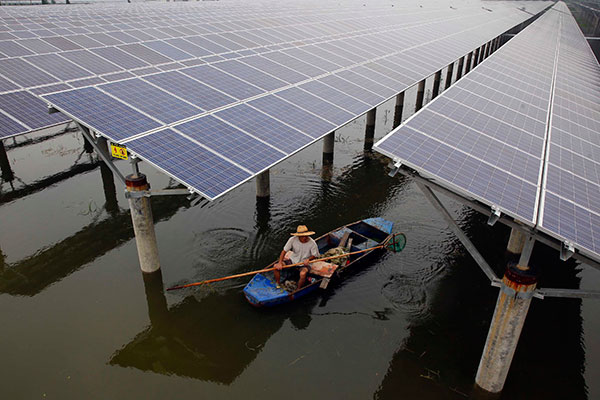Climate goal calls for push on solar, wind
(Agencies) Updated: 2015-07-03 14:18
|
 |
|
A photovoltaic power generation station built over a fish pond in Tongxiang, Zhejiang province. China is producing more solar power while planning to cut carbon emissions per unit of GDP by 60 percent to 65 percent by 2030, compared with 2005 levels. [Photo/China Daily] |
China's new pledge to curb greenhouse gas emissions means the world's biggest carbon polluter must make a more aggressive push to install solar and wind power, according to an industry association.
Faster adoption will be key to meeting commitments because other zero-emission sources such as nuclear and hydropower are constrained by safety questions and availability, said Tang Wenqian, executive deputy secretary-general of the Chinese Renewable Energy Industries Association.
Premier Li Keqiang on Tuesday promised China will cut carbon emissions per unit of GDP by 60 percent to 65 percent by 2030, compared with 2005 levels. China has already said it wants to have 200 gigawatts of wind power and 100 gW of solar by 2020.
"The nation should do more than the targets," said Tang, whose organization acts as a bridge between government policymakers and industry. "Installing 40 or 50 gigawatts of solar power a year is possible."
For 2015, China plans to add about 18 gW of solar power capacity, almost equal to all the generating capacity available in the United States at the end of 2014.
China's greenhouse gas emissions have surged since 1997 when the last climate deal was signed, meaning the country now accounts for more than a quarter of the global total. China has also pledged to peak its emissions around 2030, by which time it is targeting getting 20 percent of all energy from renewables and nuclear power.
The pledge would require China to produce 30 times more solar power than the nation had at the end of 2014, or nine times more wind power.
The commitment coincides with increased installations of renewable power capacity and a push for a cap on coal, said Tian Miao, a Beijing-based analyst at North Square Blue Oak Ltd, a London-based research company with a focus on China.
China's pledges come as the nation applies the brakes to an expansion of coal-fired power plants, which consume the majority of China's fossil fuels.
"At the same time, the nation must raise its clean energy capacity," Tian said.
China's energy consumption growth weakened to 3.8 percent in 2014, the lowest since 1998, as the economy expanded at its slowest pace since 1990.
The world's biggest energy consumer got 11 percent of its primary energy from non-fossil fuels including renewables and nuclear power in 2014, up from 9.8 percent a year earlier, the National Energy Administration said on Dec 31.
The proportion of coal fell to 64.2 percent last year from 66 percent in 2013, according to the NEA.
The nation's emissions of carbon dioxide fell last year for the first time in more than 10 years, according to a Bloomberg New Energy Finance estimate based on preliminary energy demand data from China's National Bureau of Statistics.
China led in renewables last year with investments of $89.5 billion, accounting for almost one out of every three dollars spent on clean energy in the world, according to Bloomberg New Energy Finance figures released in January.
- 2015 China International Fair for Investment and Trade kicks off in Xiamen
- China's commodity imports robust in Jan-Aug period
- China stocks rebound 2.92%
- 2015 China box office already past 2014 total
- China foreign trade decline widens in August
- Interview: JP Morgan's senior executive bullish on China
- Innovation, development the focus for NZ mayors
- Lives of freelancers

















